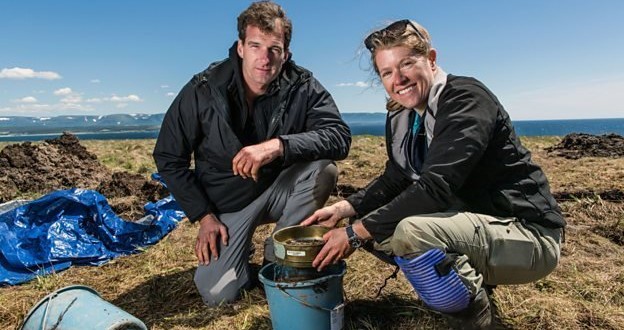A team of archaeologists say they’ve made a potentially “seismic” discovery in Canada that could “rewrite the history of Vikings in the New World” — and they did it with the help of medieval sagas and the latest satellite technology.
Images of what appear to be man-made objects deep in the ground taken by satellite indicate a Viking settlement in North America, which is located further south than ever before discovered. The Canadian site was pinpointed the summer of 2015 after infrared images from 400 miles (600km) in space.
Images showed possible man-made structures beneath vegetation on Point Rosee on the southwest coast of Newfoundland. This is 300 miles (480km) south of L’Anse aux Meadows, which is so far the only confirmed Viking settlement anywhere in North America, discovered in 1960.
The Vikings clearly reached the tip of the continent, but what happened after that is a mystery. Top space archaeologist Sarah Parcak initially located several possible indications of Viking settlements using high-resolution aerial photography of land in southeast Canada down through northeastern US.
She finally focused on the Newfoundland site after finding elevated iron readings, a stone hearth, bits of molten ore and other possible signs of metallurgy and iron work unique to Vikings. Radiocarbon tests also dated discovered materials to the Norse era.
The findings will be part of an upcoming special on PBS called Vikings Unearthed about the modern-day search for what remains of Viking settlements. Vikings were master shipbuilders, seafarers, traders and warriors.
They first launched from the Scandinavian fjords beginning in the 8th century and rampaged through Asia and the Middle East, North Africa and Europe. They focused particularly on the British Isles, and west to Iceland and Greenland.
The Newfoundland findings could significantly extend modern-man’s understanding of the Vikings. The Viking literature known as the sagas “suggest a short period of activity and a very brief and failed colonisation attempt,” Douglas Bolender, an archaeologist specialising in Norse settlements, told the National Geographic.
“L’Anse aux Meadows fits well with that story but is only one site. Point Rosee could reinforce that story or completely change it if the dating is different from L’Anse aux Meadows. We could end up with a much longer period of Norse activity in the New World.”
Agencies/Canadajournal
 Canada Journal – News of the World Articles and videos to bring you the biggest Canadian news stories from across the country every day
Canada Journal – News of the World Articles and videos to bring you the biggest Canadian news stories from across the country every day



